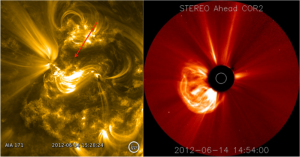Our paper on estimating the intrinsic magnetic structure of coronal mass ejections (CMEs) was published today in Solar Physics. This topic is highly important for solar and space weather research. Without knowledge of the magnetic structure in erupting CMEs we cannot predict space weather and cannot study properly how CMEs initiate and evolve in the corona and in interplanetary space. Currently, the magnetic field in the corona cannot be measured reliably (as corona it is so hot and tenuous). The only way to get information in advance is through modelling or using in-direct proxies based on remote-sensing observations.
In this paper we estimate the magnetic structure for two active region CMEs. Both turned out to be more complex than we initially anticipated. One of these events erupted in two phases and the other one started quite high in the corona. In addition, active region CMEs usually lack clear filament counterpart. This means that we could not use fully indirect proxies relying on filament characteristics. However, by combining a wide range of different techniques based on multi-wavelength solar observations we were able to estimate the magnetic structure for these CMEs. See our paper in Solar Physics and arXiv
Here are some nice pictures of the eruptions we studied. On left is the erupting flux rope in Extreme Ultraviolet from Solar Dynamics Observatory and on right the CME captured in white-light coronagraph onboard STEREO-A spacecraft.
